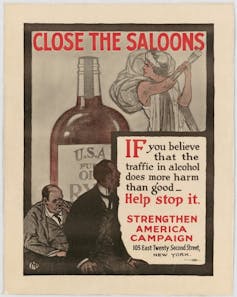Kyle Volk's Course Featured in The Conversation

is an occasional series from The Conversation U.S. highlighting unconventional approaches to teaching.
Title of course:
“Intoxication Nation: Alcohol in American History”
What prompted the idea for the course?
I wanted to get —˝ºß÷±≤• excited about studying the past by learning about something that is very much a part of their own lives.
Alcohol – somewhat surprisingly to me at first – featured prominently in my own research on in the mid-19th century. As a result, I knew quite a bit about and during that period. Designing this course allowed me to broaden my expertise.
What does the course explore?
Prohibition is a must-do subject. Students expect it. But I cover several hundred years of history: from the 17th-century – as a byproduct of sugar produced by enslaved people – to the and in the 21st century.

Along the way, I’m thrilled when —˝ºß÷±≤• get excited about details that allow them to taste a more complicated historical cocktail. For example, they learn why was crucial to the survival of colonial Virginia. The short answer: Potable water was in short supply, alcoholic drinks were far healthier, and white men – and their indentured and enslaved workforce – were busy raising tobacco. It fell to women to turn fruit into salvation.
Why is this course relevant now?
Alcohol remains a big and almost inescapable part of American society. But of late, Americans have been drinking differently – and thinking about drinking differently.
Examples abound. Alcohol producers, we learn, now face . Drinking levels , yet interest is . The that brought some mothers together now faces .
And, of course, there’s the never-ending debate about the and . Of late, the risks seem to be .
What’s a critical lesson from the course?
Alcohol has been a highly controversial, central aspect of the American experience, shaping virtually all sectors of our society – political and constitutional, business and economic, social and cultural.
What materials does the course feature?
-
Historian “”: a classic social history explaining why Americans in the early 19th century drank twice as much per capita as we do today
-
Jack London’s alcoholic memoir, “”: a deep dive into the notorious workingmen’s saloons of the industrial era, as well as one person’s reckoning with alcoholism
-
“”: the 1962 film starring Jack Lemmon and Lee Remick that spotlighted the place of alcoholic marriages and Alcoholics Anonymous in post-World War II America
-
“”: a provocative early 2000s assessment of college sports and the surrounding party culture vis-a-vis declining academic standards – still relevant today
What will the course prepare —˝ºß÷±≤• to do?
Like any history course, this one aims to develop student’s analytical, written, research and verbal skills. In lots of ways, the topic is just a tool to get —˝ºß÷±≤• to grow their brains. But I also seek to grow —˝ºß÷±≤•’ critical awareness of the place of alcohol in their own lives. The course has also informed —˝ºß÷±≤•’ paths after graduation – including some who wound up working in the alcohol industry or recovery organizations.